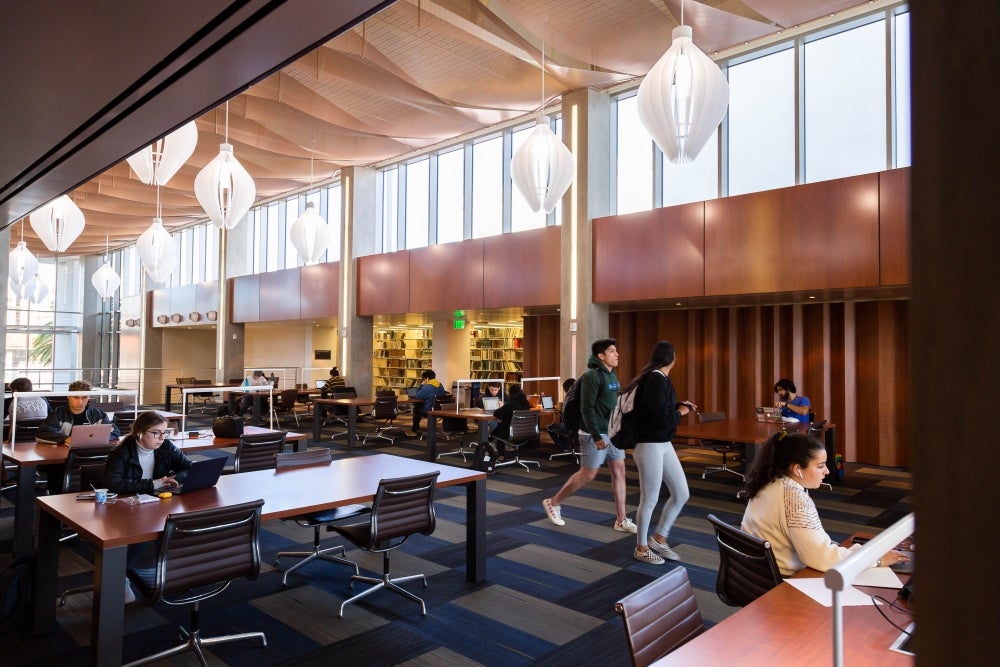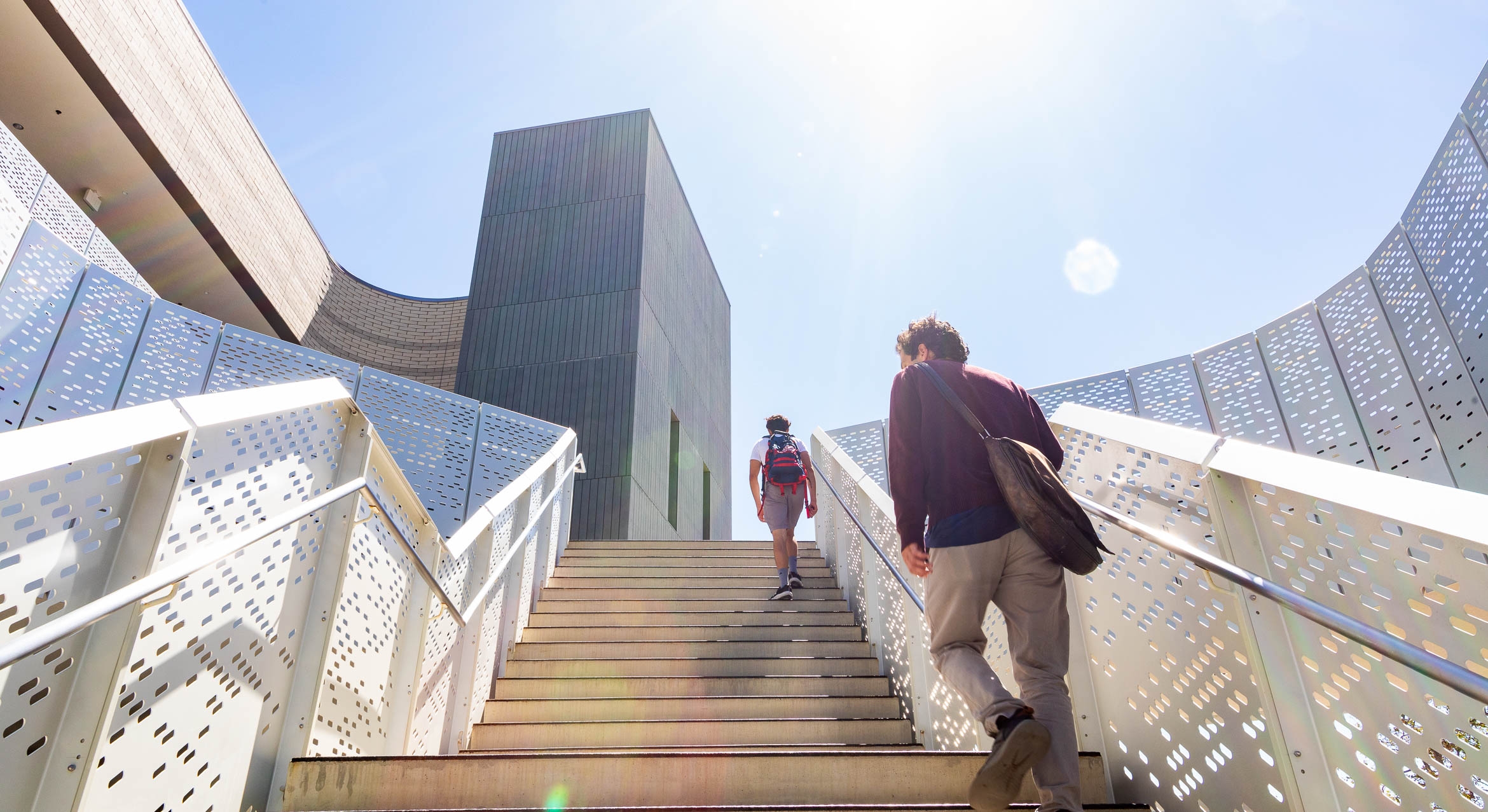
Quality and Quantity
With commencement week underway for the UC Santa Barbara Class of 2021, several graduating seniors and one faculty member have earned special recognition for their contributions to undergraduate research. Chancellor Henry T. Yang and the UCSB Library have each announced their award winners for 2021.
The Chancellor’s Award for Excellence in Undergraduate Research has four student winners: Noelle Barr, who will earn bachelor of art degrees in music and in the history of art and architecture; Alec Cao, who is graduating with a degree in physics; Irene Chen, who has completed a degree in communication; and Jack Kilgore, whose degree is in computer science.
David Weld, an associate professor of physics, has received the chancellor’s faculty award for mentoring undergraduates in research. Weld and Cao, who worked in Weld’s lab, nominated each other for the honor.
As a double major, Barr combined her interests to produce a senior thesis for which she engaged in both musicological and art historical research. Focusing on paintings by Impressionist painter Berthe Morisot of her daughter Julie playing the violin, Barr explored the social history of violinists — particularly women violinists in the 19th century — and considered the gendered spaces of modernity.
“It can be difficult for an undergraduate to find something original in the heavily researched area of Impressionism but Noelle’s efforts convinced me otherwise,” wrote Laurie Monahan, chair of the history of art and architecture department, in nominating Barr for the award. “Using French documents and knowledgeable in the details of the violin and performance, Noelle elucidated the kinds of acceptable performances for women in public and in private quarters, arguing for the instrument as something more than a token of refinement befitting a bourgeois woman. Her arguments grew stronger as her theoretical understanding of feminist theory and research expanded.”
Barr has also received a UCSB Library Award for Undergraduate Research and the Howard C. Fenton Award, a research fellowship. She was invitated to participate in the prestigious Richard Macksey National Undergraduate Humanities Research Symposium, and published a paper in The Macksey Journal.
Cao, too, has published during his years at UCSB, and worked in the lab of physicist David Weld, who specializes in experimental ultracold atomic physics. In his nomination of Cao, who he first met as a high school student, Weld described his mentee as a “truly unusual talent in the lab” and stated, “I can say unequivocally that he is the strongest undergraduate scientist I have worked with in my career.”
“Ultracoldatomic physics is a technically demanding field; the complex optical and electronic systems which comprise a quantum degenerate gas machine stretch the limits of tabletop experimentation,” Weld wrote. “Most strong undergraduates spend their entire time at UCSB working on a subset of these systems; Alec has already mastered them all.”
Cao has also been recognized nationally for his accomplishments, named a Goldwater Scholar and offered competitive National Science Foundation and National Defense Science and Engineering Graduate fellowships. He is the third UCSB student ever to win a Churchill Scholarship, which he will use to pursue research at Cambridge University.
Chen will graduate with a degree in communication. She joined the honors program in her third year, the only junior to be admitted. Passionate about the student of human-computer interaction, Chen designed an experimental study and completed an honors thesis in fall 2020 for which she developed a community-based disaster preparedness framework to address the research question of how the design of social media platforms can support disaster preparedness on a communal level. She adapted her thesis into a paper that has been accepted for publication.
Nominator Jennifer Gibbs, a professor of communication, described Chen as “an exceptional student and scholar who has demonstrated outstanding research potential.”
“She holds herself to the highest standards of excellence in her work and in everything she does, which is reflected in her top-notch writing and analytical skills. She is relentless in her pursuit of knowledge,” Gibbs wrote, further characterizing her student as a “thorough and rigorous researcher.”
Chen is moving on to graduate study at Carnegie Mellon University and is considering an academic career.
Jack Kilgore will stay on at UCSB after earning his bachelor’s degree in computer science, choosing to next pursue a master of science in the university’s Media Arts and Technology program. Kilgore spent nearly two years working with MAT professor Curtis Roads on a research project — sparked by his own initiative — to develop a new application for granular synthesis.
“Jack Kilgore’s research exemplifies UCSB’s commitment to interdisciplinarity as it combines engineering and the arts,” Roads wrote in his nomination, which also cited Kilgore’s initiative, determination, commitment and team mentality.
The Chancellor’s Faculty Award for Undergraduate Research Mentoring winner is David Weld. He was nominated by colleague Claudio Campagnari, professor and chair of physics, who noted his “demonstrated, longstanding commitment to enhancing undergraduate research at UCSB,” as well as the “quality and quantity of [his] direct mentorship activities.”
Weld also was nominated by two of his students — including Alec Cao, one of the student winners of the same award.
“His mentorship has catalyzed my tremendous growth, providing me opportunities and achievements ranging from national level scholarships to multiple first-author publications.” Cao wrote of Weld. “He is committed to empowering undergraduate students with projects they can take full ownership of providing them the necessary scientific guidance to achieve success in these roles.”
Undergraduate research mentorship has been a strong focus for Weld since he joined the UCSB faculty in 2011. He has directly mentored more than 30 undergraduate researchers in his lab, and served as an instructor for more than 35 student-quarters of the independent-research course Physics 199. He has been a faculty mentor for 7 L&S honors projects in independent research, and has supervised 10 undergraduate theses.
His students have won national awards and fellowships and published in peer-reviewed publications — in some cases as first authors. Many have gone on to prestigious graduate programs at institutions including Harvard, Stanford, Princeton, and Caltech. Weld also trains other faculty mentors of undergraduate researchers and secured federal funding for a career pathways program to support underrepresented minority students in STEM disciplines.
The increasingly competitive Library Award for Undergraduate Researchers (LAUR) recognizes students who produce a scholarly or creative work that makes expert and sophisticated use of the collections, resources and services of the UCSB Library. First- and second-place recipients in each of three broad categories receive $750 (1st place) and $500 (2nd place).
Among the six recipients for 2021 is Noelle Barr, also a Chancellor’s Award winner, who won first place in the Humanities and Fine Arts category for her paper, “Reinterpreting Gendered Spaces of Modernity in the Portraits of a Violinist.” Second place for HFA went to Stephanie Ando, a double-major in the history of art and architecture and political science, for the paper “New Japanese Photography (1974): An Introduction to Postwar Japanese Photography.”
In the social sciences, first place went to environmental studies major Samantha Ellman for her project “The Pedestrianization of State Street and its Effect on Greenhouse Gas Emissions”; second place was awarded to France Woo, a sociology major, for “United Front Article - Living History Project.”
Both spots in the science and engineering category were snared by third-year chemistry students. Yilin Cao for “Avoid Relying on Hazardous Organic Solvents for your Organic Reactions: Water as the Reactive Medium,” won first place; and Ziguang Yang took second place for “Literature Review of Gold Catalyzed Ring Enlargement.”



